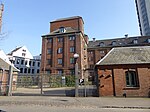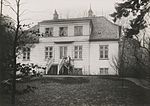Rahbeks Allé
Streets in Frederiksberg

Rahbeks Allé is a street located on the border between Frederiksberg and Vesterbro in Copenhagen, Denmark. It runs from Vesterbrogade in the northeast to the corner of Søndermarken in the southwest where it joins Pile Alle just before it turns into Valby Langgade on the border to Valby.The former Carlsberg brewery site which is under transformation into a new, dense neighbourhood is located on the south side of the street. Its north side is lined with low, mostly three-storey late-19th century apartment buildings with small front gardens.
Excerpt from the Wikipedia article Rahbeks Allé (License: CC BY-SA 3.0, Authors, Images).Rahbeks Allé
Rahbeks Allé, Frederiksberg Municipality
Geographical coordinates (GPS) Address Nearby Places Show on map
Geographical coordinates (GPS)
| Latitude | Longitude |
|---|---|
| N 55.6692 ° | E 12.5347 ° |
Address
Rahbeks Allé 15
1801 Frederiksberg Municipality
Capital Region of Denmark, Denmark
Open on Google Maps











